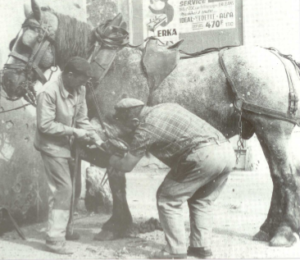Panneau n° 61
En Français
Autrefois, un Charron, puis un Maréchal – Ferrant…
Lucien Champin, charron dans cet atelier, était bien placé pour voir l’évolution du tourisme.
Raymond, son petit-fils (le plus ancien du village aujourd’hui), se souvient de peintres installant leur chevalet non loin de l’atelier de son grand-père.
Peut-être faisaient-ils partie des grands peintres qui ont immortalisé Clécy à cette époque.
( Moteley … Pissaro… ou Hardy…)?
Monsieur Romain, maréchal – ferrant et forgeron, a pris sa suite jusqu’à la guerre. Il forgea de nombreuses grilles ou autres ferronneries pour un marché local important à l’époque.
In Italiano
C’era un tempo… un carrozzaio e poi un maresciallo.
Lucien Champin, carrozzaio in questo spazio, era ben posizionato per vedere l’evoluzione del turismo.
Il nipote Raymond (il più anziano del villaggio nel 2016), si ricorda dei pittori che mettevano il proprio cavalletto poco lontano dall’atelier di suo nonno.
Probabilmente facevano parte dei grandi pittori che hanno immortalato Clécy di quell’epoca.
(Moteley ? Pissarro.. oppure Hardy…).
Monsieur Romain, maresciallo e fabbro, prese il testimone fino alla guerra. Fabbricava griglie e altri manufatti per un mercato locale dell’epoca.
In English
Once a wheelwright/blacksmith forge.
Lucien Champin was a wheelmaker. He made then in his workshop at a time when tourists became a wecome sight.
Around this time, Raymon, his grandson (the oldest person in the village to-day), remembers installing his easels and painting near his grandfather’s workshop. Perhaps he had vision of the great artists who immortalised Clécy at that time… like Moteley, Pissarro or Hardy!
Mr; Romain, a forger/blacksmith ran his workshop just until the war. He made many railings and other forms of works in iron, an important trade during this time.

